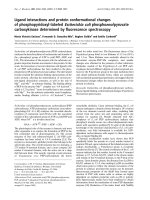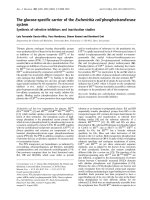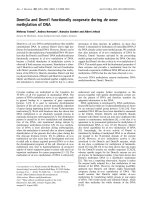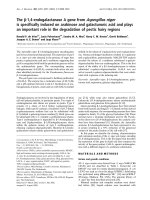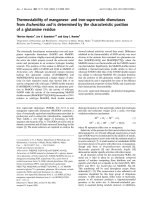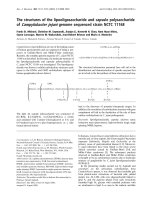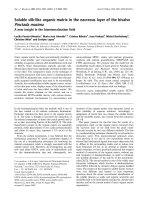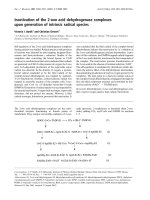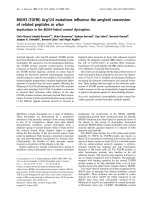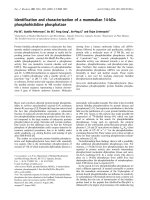Tài liệu Báo cáo Y học: Re-oxygenation of hypoxic simian virus 40 (SV40)-infected CV1 cells causes distinct changes of SV40 minichromosome-associated replication proteins doc
Bạn đang xem bản rút gọn của tài liệu. Xem và tải ngay bản đầy đủ của tài liệu tại đây (442.19 KB, 11 trang )
Re-oxygenation of hypoxic simian virus 40 (SV40)-infected CV1 cells
causes distinct changes of SV40 minichromosome-associated
replication proteins
Hans-Jo¨ rg Riedinger, Maria van Betteraey-Nikoleit and Hans Probst
Physiologisch-Chemisches Institut der Universita
¨
tTu
¨
bingen, Germany
Hypoxia interrupts the initiation of simian virus 40 (SV40)
replication in vivo at a stage situated before unwinding of
the origin region. After re-oxygenation, unwinding followed
by a synchronous round of viral replication takes place.
To further characterize the hypoxia-induced inhibition of
unwinding, we analysed the binding of several replication
proteins to the viral minichromosome before and after
re-oxygenation. T antigen, the 34-kDa subunit of replication
protein A (RPA), topoisomerase I, the 48-kDa subunit of
primase, the 125-kDa subunit of polymerase d,andthe
37-kDa subunit of replication factor C (RFC) were present
at the viral chromatin already under hypoxia. The 70-kDa
subunit of RPA, the 180-kDa subunit of polymerase a,and
proliferating cell nuclear antigen (PCNA) were barely
detectable at the SV40 chromatin under hypoxia and signi-
ficantly increased after re-oxygenation. Immunoprecipita-
tion of minichromosomes with T antigen-specific antibody
and subsequent digestion with micrococcus nuclease
revealed that most of the minichromosome-bound T antigen
was associated with the viral origin in hypoxic and in
re-oxygenated cells. T antigen-catalysed unwinding of the
SV40 origin occurred, however, only after re-oxygenation as
indicated by (a) increased sensitivity of re-oxygenated
minichromosomes against digestion with single-stranded
DNA-specific nuclease P1; (b) stabilization of RPA-34
binding at the SV40 minichromosome; and (c) additional
phosphorylations of RPA-34 after re-oxygenation, probably
catalysed by DNA-dependent protein kinase. The results
presented suggest that the subunits of the proteins necessary
for unwinding, primer synthesis and primer elongation first
assemble at the SV40 origin in form of stable, active
complexes directly before they start to work.
Keywords: hypoxia; DNA unwinding; SV40; large T antigen;
replicon initiation.
DNA replication in mammalian cells is subject to a
regulation, which depends on the O
2
tension in the cellular
environment. This regulation results in inhibition of cellular
replicon initiation when the concentration of O
2
falls below
0.1%. Re-oxygenation after several hours of hypoxia causes
a burst of new initiations within a few minutes. So far, this
regulatory phenomenon has been demonstrated for Ehrlich-
ascites, HeLa and CCRF cells [1–3] and it may be a general
mechanism, which adapts the cellular DNA replication to
the supply of O
2
and other nutrients. This seems to be of
particular significance during embryonic growth, wound
healing or tumour cell propagation.
The mechanism leading from re-oxygenation to replicon
initiation is largely obscure. The remarkably fast resumption
of initiations after re-oxygenation suggests that the
O
2
-dependent replication control acts very directly on the
replication apparatus.
O
2
-Dependent regulation of replicon initiation was also
demonstrated for viral replication in simian virus 40 (SV40)-
infected CV1 cells [4,5]. As the replication of SV40 is
relatively well investigated, this virus seems to be well suited
to examine the events leading to the reversible shutdown of
replicon initiations by hypoxia. As we have shown, reduc-
tion of the pO
2
to 0.1–0.02% suppresses the viral DNA
synthesis. Re-oxygenation results in new initiations followed
by an almost synchronous round of SV40 replication. This
synchronous round of replication was shown to begin at the
viral origin [4].
After re-oxygenation, the viral replication starts with the
unwinding of the viral origin region [5]. This was shown by
detection of a highly underwound SV40 topoisomer (form
U) about 3 min after re-oxygenation. Form U was not
detectable under hypoxia. Primer RNA-DNA synthesis was
started 3–5 min after re-oxygenation. As form U turned
out to contain primer RNA-DNA, unwinding and primer
synthesis may occur more or less concomitantly after the
initial opening of the viral origin region.
In vitro, the events leading to unwinding of the viral origin
and subsequent DNA synthesis are characterized by the
binding of replication proteins to the SV40 origin. First, in
an ATP-dependent reaction, SV40 large T antigen binds as
a double hexamer to the viral origin, leading to local
distortions of the origin region [6–11]. Further local
unwinding, catalysed by the helicase activity of the T
antigen, depends on the binding of replication protein A
(RPA) and topoisomerase I [12–15]. After a stretch of
Correspondence to H J. Riedinger, Physiologisch-chemisches Institut
der Universita
¨
tTu
¨
bingen, Hoppe-Seyler-Straße 4, D-72076 Tu
¨
bingen,
Germany.
Fax: + 49 7071293339, Tel.: + 49 70712972454,
E-mail:
Abbreviations: SV40, simian virus 40; RPA, replication protein A;
RFC, replication protein C; PCNA, proliferating cell nuclear antigen;
ATM, ataxia telangiectasia-mutated.
(Received 18 December 2001, revised 20 March 2002,
accepted 22 March 2002)
Eur. J. Biochem. 269, 2383–2393 (2002) Ó FEBS 2002 doi:10.1046/j.1432-1033.2002.02902.x
unwound DNA is generated, DNA polymerase a-primase
synthesizes RNA-DNA primers at the single-stranded
templates [16–18]. Elongation of these primers involves
replication factor C (RFC), proliferating cell nuclear antigen
(PCNA), and DNA polymerase d [19–21].
In the present communication, we further try to define the
state, at which hypoxia interrupts the initiation of SV40
replication in vivo, by examining which replication proteins
are present in the viral minichromosome before and after
re-oxygenation. The presented data indicate that unwinding
occurs immediately after re-oxygenation but not under
hypoxia. We further demonstrate that a significant fraction
of the proteins engaged in viral replication is bound to the
SV40 minichromosome already under hypoxia, but that
none of the protein complexes necessary for unwinding,
primer synthesis and elongation seems to be completed
before the respective events actually take place.
MATERIALS AND METHODS
Transient hypoxia, re-oxygenation and radioactive
labelling
Monkey CV1 cells (ATCC CCL 70) were grown and
infected with SV40 as described previously [22]. Transient
hypoxia was started 36 h after infection by gassing with
0.04% O
2
/5% CO
2
and Ar to 100% for 6 h [4]. For
re-oxygenation, 0.25 vol. of medium equilibrated with
95% O
2
/5% CO
2
was added to the hypoxic cell culture
and gassing was continued with artificial air [4].
To label newly formed DNA, [methyl-
3
H]deoxythymi-
dine was either added directly to the cells or, for hypoxic
labelling, by plunging a spatula carrying the appropriate
quantity in dried form into the culture medium. For
long-term labelling of DNA, [2-
14
C]deoxythymidine
(5 nCiÆmL
)1
) was added to the cell cultures immediately
after infection with SV40.
Staurosporine (Roche, Mannheim, Germany), olomou-
cine (ICN, Eschewed, Germany) or wortmannin (Alexis,
Gru
¨
nberg, Germany), dissolved in dimethylsulfoxide, were
applied to hypoxic cell cultures on a spatula after gassing in
a hypoxic chamber for 30 min.
To stop incubations, the culture medium was removed by
aspiration and the cells were washed twice with ice-cold
NaCl/P
i
[150 m
M
NaCl, 10 m
M
NaHPO
4
,(pH7.0)].The
determination of acid-insoluble radioactivity has been
described previously [23].
Preparation of SV40 minichromosomes
Preparation of SV40 minichromosomes was performed
essentially as described by Su & DePamphilis [24]. In brief,
SV40-infected CV1 cells of Petri dishes 132 mm in diameter
were used for preparation of the minichromosomes.
Stopped cell cultures were washed twice with ice-cold
hypotonic buffer [10 m
M
Hepes/KOH (pH 7.8), 5 m
M
KCl,
0.5 m
M
MgCl
2
,0.1m
M
dithiothreitol]. Cells were homo-
genized with five strokes in a Dounce homogenizer and the
nuclei were pelleted by centrifugation at 3000 g for 5 min.
After resuspension in hypotonic buffer containing protease
inhibitor cocktail (Sigma, Deisenhofen, Germany), the
nuclei were eluted for 1.5 h at 0 °C and then pelleted by
centrifugation at 8000 g for 10 min. The minichromosomes
in the supernatant were sedimented at 14 000 g in a
Beckman TLA 100.2 rotor for 25 min at 4 °Cand
resuspended in an appropriate buffer. Addition of ATP
(4 m
M
) during the preparation of the minichromosomes
was never found to change the results obtained. This step
was therefore generally omitted.
Alkaline sedimentation analysis of viral DNA
in isolated minichromosomes and in nuclei
SV40-infected cells were incubated at atmospheric pO
2
or
re-oxygenated after 6 h of hypoxia for 10 or 25 min. Ten
minutes before the end of incubation, cells were pulse-
labelled with 10 lCiÆmL
)1
[methyl-
3
H]deoxythymidine.
Incubation was then stopped and minichromosomes were
eluted from the nuclei for 1.5 h as described above. After
sedimentation of the nuclei, the minichromosome-con-
taining supernatant or the nuclei resuspended in NaCl/P
i
were brought to 0.2
M
NaOH, incubated for 1 h at room
temperature and loaded on top of a 5–40% linear
sucrose gradient in 0.25
M
NaOH, 0.6
M
NaCl, 1 m
M
EDTA, 0.1% sodium lauroylsarcosinate. After centrifu-
gation in a Beckman SW40 rotor at 164 000 g and 23 °C
for 16 h, 0.6-mL fractions were collected from the top of
the gradient and analysed for acid-insoluble radioactivity
[23].
Electrophoresis of minichromosome-bound proteins,
Western blotting
Minichromosomes resuspended in NaCl/P
i
were diluted
with 10 vol. of 10 m
M
sodium pyrophosphate and 10 m
M
EDTA (pH 8.0), and proteins were extracted with 4 vol. of
phenol (pH 8.0). The phenolic phase was then extracted
twice with the same volume of 10 m
M
sodium pyrophos-
phate, 10 m
M
EDTA (pH 8.0) and proteins were precipi-
tated by addition of 5 vol. of acetone at )20 °Covernight.
After centrifugation at 200 000 g,4°C for 45 min, the
pellet was successively washed with chloroform/CHCl
3
and
methanol, dried and redissolved in 5 m
M
Tris/HCl
(pH 7.5).
The proteins were separated on an 8% SDS/polyacryl-
amide gel [25] and then blotted onto a nitrocellulose
membrane with a semidry blot device (Pharmacia, Freiburg,
Germany). Immunodetection of replication proteins was
done with the ECL Western blotting kit (Amersham,
Freiburg, Germany) according to the protocol of the
manufacturer. Dilutions of antibodies used were as follows:
T antigen (monoclonal antibody, clone pAB 101, kind gift
of H. Stahl, Homburg/Saar, Germany), 1 : 100 of the
hybridoma supernatant; RPA (monoclonal antibodies
against the 34-kDa and 70-kDa subunits, kind gifts from
J. Hurwitz, Memorial Sloan Kettering Cancer Center, New
York, USA), 1 : 200 and 1 : 100 of the hybridoma super-
natant, respectively; topoisomerase I (polyclonal antibody,
TopoGen Inc., Columbus, USA), 1 UÆmL
)1
; primase
(polyclonal antibody against the 48-kDa subunit, kind gift
of H P. Nasheuer, Institut fu
¨
r medizinische Biochemie,
Jena, Germany), 1 : 2000; polymerase a (polyclonal anti-
body against the 180-kDa subunit, kind gift of H P.
Nasheuer, Institut fu
¨
r medizinische Biochemie, Jena,
Germany), 1 : 1000; RFC (polyclonal antibody against
the 37-kDa subunit, a kind gift of J. Hurwitz, Memorial
2384 H J. Riedinger et al. (Eur. J. Biochem. 269) Ó FEBS 2002
Sloan Kettering Cancer Center, New York, USA), 1 : 1000;
PCNA (monoclonal antibody, clone 19F4, Roche,
Mannheim, Germany) 2 lgÆmL
)1
; polymerase d (monoclo-
nal antibody against the 125-kDa subunit, Transduction
laboratories, Heidelberg, Germany) 1 : 1000.
Digestion of immunoprecipitated minichromosomes
with micrococcus nuclease and correlation
of the digestion products with the SV40 genome
SV40-infected cells were incubated hypoxically for 6 h and
simultaneously labelled with [methyl-
3
H]deoxythymidine
(10 lCiÆmL
)1
). Thereafter, cells were either stopped or
re-oxygenated for 6 min and then stopped. Minichromo-
somes were isolated as described above. For immunopre-
cipitation, 10 mL of T antigen-specific hybridoma
supernatant (clone pAB 101) were incubated with pro-
tein A agarose (20 mg, Biorad, Richmond, USA) for 1 h
at 4 °C. Thereafter, protein A agarose was pelleted and
minichromosomes were bound by incubation for 90 min at
4 °C in NET buffer [150 m
M
NaCl, 50 m
M
Tris/HCl
(pH 7.5), 5 m
M
EDTA, 0.5% Nonidet P40]. The immu-
noprecipitate was then washed three times with NET
buffer and resuspended in 500 lL Tris/HCl, pH 7.4
(10 m
M
), CaCl
2
(1 m
M
). Subsequently, digestion with
micrococcus nuclease (48 U) was performed at 37 °Cfor
25 min. The immunoprecipitate and the supernatant were
then incubated for 1 h at 37 °C with proteinase K
(40 lgÆmL
)1
), SDS (0.5%) and extracted with phenol/
CHCl
3
. The DNA was precipitated with ethanol, redis-
solved and hybridized against membrane-fixed, single-
stranded M13mp18 DNA containing segments of the
SV40 genome cloned in either direction into the plasmid
SmaI site by standard procedures [26]. For fixation of the
single-stranded SV40 probes onto nylon membrane,
400 ng DNA was dissolved in 200 lL10· NaCl/Cit
(1.5
M
NaCl, 0.15
M
sodium citrate, pH 7.0), heated to
65 °C for 10 min and chilled on ice. The DNA was then
transferred to the membrane (2 cm in diameter), dried at
37 °C and fixed by UV irradiation. Hybridization was
performed at 37 °C, as described previously [27]. After
hybridization, the radioactivity bound to each of 14
probes, representing both complementary DNA strands
of seven SV40 genome fragments (see inset in Fig. 3), was
quantified and normalized for size of the respective SV40
segment.
Nuclease P1 digestion of SV40 minichromosomes
SV40 minichromosomes isolated from hypoxic and
re-oxygenated cell cultures were digested with nuclease P1
essentially as described by Adachi & Laemmli [28]. After
sedimentation, the minichromosomes were redissolved in
HMN buffer [5 m
M
Hepes/NaOH (pH 7.5), 8 m
M
MgCl
2
,
100 m
M
NaCl] and one half was digested with 1 U of
nuclease P1 [Pharmacia, Freiburg, Germany; 1 UÆlL
)1
stockin8.5m
M
sodium acetate (pH 6.0), 50% glycerol] for
10 s at 37 °C. Digestion was stopped by the addition of
15 vol. of ice-cold RIPA buffer. Thereafter, minichro-
mosomes were immunoprecipitated with T antigen-anti-
body-saturated protein A agarose and digested with
proteinase K, as described above. After phenol/CHCl
3
extraction, DNA was precipitated with ethanol and
analysed on a 1% agarose gel in TAE buffer [40 m
M
Tris,
5m
M
sodium acetate, 1 m
M
EDTA (pH 7.8)].
SV40 DNA isolation from cell cultures, chloroquine gel
electrophoresis, Southern blotting, hybridization
SV40 DNA from whole cells was isolated as described
previously [5]. Washed cells were lysed and digested in
0.25
M
EDTA (pH 8.0), 1% sodium lauroylsarcosinate and
100 lgÆmL
)1
proteinase K at 55 °C for 3 h. The lysate was
then extracted twice with phenol/CHCl
3
and dialyzed
against 1 m
M
Tris/0.1 m
M
EDTA (pH 8.0) at 4 °Cover-
night. After digestion with RNase A (100 lgÆmL
)1
at 37 °C
for 1 h), 100 ng of isolated DNA per slot was loaded onto a
25 · 20 cm agarose gel containing 20 lgÆmL
)1
chloroquine
in gel buffer (30 m
M
NaH
2
PO
4
,36m
M
Tris, 1 m
M
EDTA).
Electrophoresis was carried out at 2 VÆcm
)1
and 4 °Cfor
20 h. Southern blotting was performed under alkaline
conditions [26]. The DNA was detected by hybridization
[27] using a
32
P-labeled, BamHI-linearized SV40 probe.
Competition of RPA-34 binding to minichromosomes
by single-stranded DNA
SV40 minichromosomes of hypoxic and re-oxygenated cell
cultures were eluted as described above. After sedimentation
of the nuclei, the supernatant was divided and one half was
incubated with 40 lgÆmL
)1
sonicated, heat-denatured her-
ring sperm DNA for 30 min at 30 °C, whereas the other
half was incubated without competitor DNA. Thereafter,
the minichromosomes were pelleted by ultracentrifugation,
resuspended in NaCl/P
i
and processed for Western blotting
as described above.
RESULTS
Eluted minichromosomes represent the state of viral
replication in SV40-infected cells
Elution of SV40 minichromosomes from isolated nuclei of
infected CV1 cells in hypotonic buffer usually yielded 35%
of total viral minichromosomes (data not shown). In order
to show that the eluted fraction of SV40 minichromosomes
is representative of the overall SV40 replication in the
infected cells, SV40 DNA isolated from minichromosomes
was compared with that remaining in the eluted nuclei,
using alkaline sedimentation analysis.
SV40-infected CV1 cells were either grown under atmo-
spheric pO
2
or re-oxygenated after 6 h hypoxia for 10 or
25 min and labelled with [methyl-
3
H]deoxythymidine dur-
ing the last 10 min of the incubation. SV40 minichromo-
somes and resuspended eluted nuclei were brought to 0.2
M
NaOH and incubated for 1 h at room temperature.
3
H-Labeled DNA in the lysates was then analysed for size
by alkaline sucrose gradient centrifugation. As a control,
noninfected, normoxically cultivated CV1 cells where trea-
ted exactly in the same way.
Figure 1 shows that there were no significant differences
between the peak positions, i.e. the lengths of growing DNA
strands, in minichromosomes and nuclei. Incubating cell
cultures under atmospheric pO
2
(Fig. 1A,B) resulted in
peaks around fraction 10, representing full-length SV40
DNA. Additionally, a peak at fraction 18, representing
Ó FEBS 2002 Initiation of SV40 replication in vivo (Eur. J. Biochem. 269) 2385
covalently closed, supercoiled SV40 DNA was visible.
Accordingly, this peak was predominant in long-term
labelled DNA (circles). Minichromosomes containing
long-term labelled (supercoiled) SV40 DNA seemed to
preferably remain in the nuclei, as only 10–20% were eluted
compared to 30–50% of the pulse-labelled (replicating)
SV40 DNA (squares). With re-oxygenated cells, peaks at
fraction 8, representing growing DNA of 2 kb, 10 min
after re-oxygenation (Fig. 1C,D), and at fraction 11,
representing full length DNA, 25 min after re-oxygenation
(Fig. 1E,F), were obtained.
Essentially the same profiles were found when viral
DNA of whole SV40-infected cells cultivated under the
same conditions was analysed [4,5]. The fraction of eluted
SV40 minichromosomes was therefore taken to be repre-
sentative of the overall minichromosomes in infected cells.
Figure 1G,H shows the sedimentation profiles of nonin-
fected CV1 cells. As expected, no DNA was found in the
eluate of nuclei (Fig. 1G), whereas DNA of the nuclei
sedimented to the bottom (fraction 20) of the sucrose
gradient (Fig. 1H). These results suggest that the sedi-
mentation profiles shown in Fig. 1A–F are specific for
SV40.
Differential pattern of minichromosome-bound
replication proteins occur before
and after re-oxygenation of hypoxic cells
Initiation of SV40 DNA replication is inhibited at a stage
before unwinding in hypoxically cultivated cells. After
re-oxygenation, unwinding and RNA-DNA primer synthe-
sis are detectable after 3 min [5].
We asked whether re-oxygenation is accompanied by
sequential binding of different replication proteins, which
are necessary to catalyse these steps.
SV40-infected cell cultures were grown hypoxically for
6 h and stopped or re-oxygenated for 1, 3, or 5 min and
then stopped. Proteins of SV40 minichromosomes were
prepared, separated by SDS/PAGE and blotted to a
nitrocellulose membrane. Chosen proteins were then detec-
ted with specific antibodies. As quantification of Western
blots is known to be difficult, reproducibility of the results
was carefully ascertained, especially in cases where changes
before and after re-oxygenation were found to be small (e.g.
for T antigen or polymerase a-180). Each protein was tested
in at least three independent experiments and representative
results are shown in Fig. 2.
RPA-34, topoisomerase I, primase-48, RFC-37, and
polymerase d-125 were associated with the SV40 minichro-
mosomes already under hypoxia. For RPA-34 and RFC-37,
longer exposure times were chosen to accentuate slower
migrating bands. If at all, only minor differences in signal
intensities were found for these proteins irrespective whether
they were isolated from minichromosomes of hypoxic or
re-oxygenated cell cultures. In case of RPA-34 and RFC-37,
this was confirmed by shorter exposure (data not shown).
Topoisomerase I, the 34-kDa subunit of RPA and the
37-kDa subunit of RFC seemed to exist in several modi-
fications (Fig. 2). Two dimensional gel electrophoresis (first
dimension: isoelectric focusing; second dimension: SDS/
PAGE) of SV40 minichromosome-bound proteins, Western
blotting and immunodetection revealed that, for RPA-34
and RFC-37, these modifications differed significantly in
their isoelectric points but only slightly in their molecular
masses (data not shown). This suggests that they are
differently phosphorylated species. The patterns of topo-
isomeraseandRFC-37werethesameirrespectiveofthe
Fig. 1. Alkaline sucrose gradient centrifugation of viral DNA of mini-
chromosomes eluted from nuclei of normoxically cultivated or re-oxy-
genatedSV40-infectedCV1cellsandofthenucleiremainingafterthe
elution. Cells were cultivated under normoxic conditions (A,B) or
re-oxygenated after 6 h of hypoxia for 10 min (C,D) or 25 min (E,F)
and labelled with 10 lCi of [methyl-
3
H]deoxythymidine per mL during
the last 10 min of the incubation (j). Cell nuclei were eluted with
hypotonic buffer and the DNA of the minichromosomes (A,C,E) and
of the nuclei (B,D,F) was analysed by alkaline sedimentation. (G,H)
Sedimentation of DNA of noninfected CV1 cells treated exactly as
(A,B). Sedimentation was from left to right. (d) DNA labelled by
addition of [2-
14
C]deoxythymidine (5 nCiÆmL
)1
) immediately after
infection of CV1 cells with SV40.
2386 H J. Riedinger et al. (Eur. J. Biochem. 269) Ó FEBS 2002
incubation conditions, whereas RPA-34 was obviously
phosphorylated additionally after re-oxygenation. The
degree and timing of the appearance of additional phos-
phorylations of RPA-34 varied somewhat in different
experiments (compare Fig. 2 with Fig. 6B). First changes
of the phosphorylation pattern were, however, almost
always detectable as early as 1 min after re-oxygenation.
Two bands were detectable for the catalytic subunit of
polymerase d. As the difference in electrophoretic mobility
was rather pronounced considering the molecular mass of
polymerase d, it seems unlikely that the two bands represent
different phosphorylation forms of the protein. Rather, the
lower band may be a degradation product of the upper.
Recently, Schumacher et al.[29]isolatedaN-terminal
truncated form of polymerase d with an apparent molecular
mass of 116 kDa, approximately the same size as the lower
band of polymerase d detected by us.
The ratio of the intensities of both bands significantly
changed. The upper band increased 3 and 5 min after
re-oxygenation, while the lower band decreased. The sum of
the bands remained, however, largely constant. This was
especially evident in preparations that yielded essentially
equal signal intensities of both bands from the beginning.
Supposing the lower band to be a degradation product of
the upper, this result could indicate that polymerase d was
better protected against degradation when it was stably
bound to its target at the replication fork, i.e. during primer
elongation.
An unexpected binding behaviour showed T antigen.
Under hypoxia, it was associated with the chromatin but
decreased immediately after re-oxygenation to about one
third. Three minutes after re-oxygenation, the amount of
minichromosome-bound T antigen increased again and
attained the level seen under hypoxia until 5 min after
re-oxygenation.
The 70-kDa subunit of RPA, the 180-kDa subunit of
DNA polymerase a, and PCNA were barely detectable in
hypoxic minichromosomes. After re-oxygenation, the
amount of all three proteins significantly increased, though
at different times. RPA-70 increased after just 1 min and
further increased up to 3 min, remaining then at a
constant level. The amount of polymerase a-180 first
increased 3 min after re-oxygenation and remained
unchanged thereafter. PCNA also increased after 3 min
and further increased until 5 min after re-oxygenation.
These binding patterns suggest that the proteins are
recruited to the minichromosome (at least in a form bound
stably enough to resist minichromosome isolation) in the
same order they actually start to function in replication.
T antigen is bound to the viral origin of replication
in SV40 minichromosomes
Figure 2 shows that T antigen is detectable at the SV40
chromatin under hypoxia and after re-oxygenation. As
several T antigen-binding sites exist in the SV40 genome, we
determined the genome region, where T antigen is bound
under hypoxia and after re-oxygenation.
SV40 minichromosomes labelled with [methyl-
3
H]deoxy-
thymidine were isolated from hypoxic or re-oxygenated cell
cultures and immunoprecipitated using protein A agarose-
bound T antigen antibody. The immunoprecipitate was
resuspended and digested with micrococcus nuclease. After
digestion, the immunoprecipitate was pelleted by centrifu-
gation, and DNA fragments were isolated from the pellet
and the supernatant and hybridized against membrane-
fixed single-stranded probes containing different segments
of the SV40 genome (see inset of Fig. 3). For each SV40
restriction fragment, two single-stranded probes, represent-
ing both complementary DNA strands, existed. The sum of
radioactivity bound by both probes of each fragment is
showninFig.3.
DNA isolated from the immunoprecipitate, i.e. DNA
fragments that were associated with T antigen before
purification, mainly hybridized to SV40 probes 1a and 1,
irrespective whether cells were re-oxygenated for 6 min or
kept hypoxic (Fig. 3A,C). This means that T antigen is
preferably bound to the core origin (represented by
probe 1a) or to the whole SV40 origin region (represented
by probe 1). After re-oxygenation, but not under hypoxia,
some DNA also hybridized to probe 4, indicating that
T antigen was also associated with SV40 DNA containing
the termination region at this time. As 6 min of
re-oxygenation are not sufficient to allow complete replica-
tion of the whole SV40 genome [4,5], association of T
antigen with this fragment likely results from elongation of
SV40 replicons, which were started, but not yet terminated,
before or during hypoxia.
DNA fragments isolated from the supernatant of the
immunoprecipitation hybridized more or less uniformly to
all probes except 1a (Fig. 3B,D). As 1a represents the SV40
core origin, this result indicates that, in most minichromo-
somes, the core origin is protected against digestion with
micrococcus nuclease by association with T antigen.
Fig. 2. Immunodetection of minichromosome-
associated replication proteins. Minichromo-
some-bound proteins isolated from hypoxic
(H) or re-oxygenated (re-oxygenation times
are indicated) SV40-infected cell cultures were
separated by SDS-PAA gel electrophoresis,
Western blotted and detected with appropriate
antibodies.
Ó FEBS 2002 Initiation of SV40 replication in vivo (Eur. J. Biochem. 269) 2387
Sensitivity of SV40 minichromosomes to single-stranded
DNA-specific nuclease P1 increases after re-oxygenation
The slight increase in the amount of minichromosome-
bound RPA-70 together with additional phosphorylation of
RPA-34 1 min after re-oxygenation (Fig. 2) indicates the
occurrence of single-stranded DNA [30–34] and therefore
probably the beginning of unwinding of the SV40 chroma-
tin (see below).
To independently examine the existence of unwound
DNA, we used the single-stranded DNA-specific nuclease
P1. This enzyme has been successfully used in a similar
study by Adachi & Laemmli to detect unwound DNA
regions in Xenopus sperm nuclei [28].
SV40 minichromosomes of hypoxic and re-oxygenated
cell cultures were divided in two halves, and one half was
exposed to nuclease P1 and immunoprecipitated, while the
other half was immunoprecipitated without digestion. After
that, the SV40 DNA was isolated, separated on a 1%
agarose gel, blotted and detected by hybridization using a
32
P-labeled SV40-specific probe. The signal intensities of
supercoiled and open circle SV40 DNA of P1-digested and
undigested minichromosomes were quantified densitomet-
rically and compared (the undigested signal was set as
100%). Essentially no difference between the signal inten-
sities of DNA from undigested and digested minichromo-
somes of hypoxic cell cultures was found (Fig. 4). This
indicates that significant unwinding does not occur under
hypoxia. Smaller local distortions, which were detected after
binding of T antigen to SV40 site II at the early palindrome
and the AT-rich region in vitro [6–11], may exist under
hypoxia. They may, however, be protected against digestion
by micrococcus nuclease through the origin-bound T
antigen hexamer. In vitro DNase protection assays demon-
strated that the entire 64-bp core origin is protected against
digestion by DNase I, when T antigen is bound [6,35].
After re-oxygenation, the minichromosomes became
more sensitive to nuclease P1 digestion, resulting in an
increase of nicked open circle DNA and in a decrease of
supercoiled DNA compared to the undigested fraction. P1
susceptibility of the minichromosomes became apparent
just 1 min after re-oxygenation and remained constant for
longer re-oxygenation times, indicating that the length of
the unwound DNA stretch is not decisive for P1 digestion in
Fig. 3. Localization of T antigen at the SV40
chromatin.
3
H[thymidine]-labelled minichro-
mosomes isolated from hypoxic (A,B) or
re-oxygenated (C,D) SV40-infected CV1 cells
were immunoprecipitated with T antigen
antibody-saturated protein A agarose. The
immunoprecipitate was resuspended and
digested with micrococcus nuclease. After
centrifugation, DNA fragments were isolated
from the immunoprecipitate and the super-
natant and analysed by hybridization against
membrane-fixed single-stranded M13mp18
DNA containing segments of the SV40
genome (see inset). For each SV40 restriction
fragment, two single-stranded probes, repre-
senting both complementary DNA strands,
existed. The radioactivity bound to the mem-
brane-fixed SV40 probes was measured, nor-
malized for fragment size, and added up for
both probes of each SV40 genome segment.
(A,C) Membrane-bound DNA fragments of
the immunoprecipitate (A) hypoxic cells, (C)
cells re-oxygenated for 6 min; (B,D) Mem-
brane-bound DNA fragments of the super-
natant (B) hypoxic cells, (D) cells
re-oxygenated for 6 min. Inset: Cleavage sites
of restriction enzymes used to generate the set
of SV40-specific single-stranded DNA probes.
Restriction fragment 1a harbours the SV40
core origin of replication.
2388 H J. Riedinger et al. (Eur. J. Biochem. 269) Ó FEBS 2002
this test. Only about 20–30% of the minichromosomes were
sensitive to nuclease P1 digestion. As digestion of
re-oxygenated minichromosomes with one tenth of nuclease
P1 activity yielded the same amount of open circle DNA
(data not shown), it may be concluded that the digestion
was complete. This again indicates that only a minor
fraction of the immunoprecipitable minichromosomes was
actually engaged in replication 5 min after re-oxygenation.
RPA-34 is dissociated from hypoxic minichromosomes
by addition of single-stranded competitor DNA
RPA-34 was found to be associated with hypoxic mini-
chromosomes, despite of the facts that RPA-70 was barely
detectable (Fig. 2) and that the viral genome was obviously
not unwound before re-oxygenation (Fig. 4). As the inter-
action between RPA and single-stranded DNA is largely
mediated by RPA-70 [36,37], these observations together
indicate that RPA-34 is bound to the viral chromosome by
protein–protein interactions or by any other means than
interaction with single-stranded DNA under hypoxic
culture conditions. Following re-oxygenation, part or all
of the prebound RPA-34 may become integrated into the
RPA heterotrimer complex.
In order to examine which amount of RPA-34 was bound
to unwound SV40 minichromosome DNA in form of a
RPA heterotrimer complex before and after re-oxygenation,
we made use of the fact that, once bound to single-stranded
DNA, the resulting complex cannot be disrupted by excess
single-stranded competitor DNA [28]. RPA-34 bound by
other means to the SV40 minichromosome, on the other
hand, is readily displaced by excess competitor DNA
(see below), probably because it contains a single-stranded
DNA-binding motif [38,39].
We therefore treated minichromosomes isolated from
hypoxic or re-oxygenated cell cultures with an excess of
single-stranded herring sperm DNA (Fig. 5B) and com-
pared the dissociation of RPA-34 with the respective
untreated control (Fig. 5A). RPA-34 was found to be
almost totally displaced from minichromosomes of hypoxic
cell cultures. Minichromosomes from cells re-oxygenated
for longer than 3 min, on the other hand, retained part of
their RPA-34. Higher phosphorylated forms of RPA-34
were almost undetectable, as shown in Fig. 5, indicating
that they were probably not resistant to incubation at 30 °C
under the chosen conditions. Note that isolation of mini-
chromosomes was usually performed at 4 °C throughout.
Alternatively, a phosphatase may have dephosphorylated
RPA-34 during the incubation.
Minichromosome-bound RPA-70 was resistant to dis-
placement by single-stranded competitor DNA (data not
shown). Altogether, the results indicate that from only
3 min after re-oxygenation onwards, i.e. the time we have
detected significant unwinding of the SV40 genome [5], an
increasing amount of RPA-34 is bound to the viral
minichromosome in the form of a single-stranded DNA-
associated RPA trimer complex.
Phosphorylation of the 34-kDa subunit of RPA is not
essential for unwinding of the viral minichromosome
As mentioned above, the 34-kDa subunit of RPA is
additionally phosphorylated immediately after re-oxygen-
ation. Phosphorylation of p34 has been suggested to
influence initiation efficiency of SV40 DNA replication
[40] under hypoxia. In vitro, however, SV40 replication
proceeds normally, irrespective whether RPA-34 is phos-
phorylated or not [38]. Among the kinases described so far
to phosphorylate RPA-34 in vivo are cdk2-cyclin A, cdc2-
cyclin B, ataxia telangiectasia-mutated (ATM), and DNA-
dependent protein kinase [32,33,41–43]. These kinases are
effectively inhibited by staurosporine [44,45] or olomoucine
[45,46], and wortmannin [47], respectively.
To examine whether phosphorylations catalysed by the
above mentioned kinases are essential for initiation of SV40
replication after re-oxygenation, we tested the influence of
these inhibitors on the formation of SV40 form U, which
Fig. 4. Sensitivity of minichromosomes of hypoxic and re-oxygenated
cell cultures to single-stranded DNA-specific nuclease P1. Aliquots of
SV40 minichromosomes of hypoxic or re-oxygenated cells were
immunoprecipitated with immobilized T antigen-specific antibody
with or without prior digestion with P1 nuclease (1 U). SV40 DNA
was isolated, separated on an agarose gel, blotted and detected by a
32
P-labeled DNA-probe. Signal intensities of open circle and super-
coiled SV40 DNA-bands were quantified by densitometric evaluation.
The signal intensities of the undigested aliquots were set as 100%. d,
signal intensity of open circle DNA (oc); j,signalintensityofsuper-
coiled DNA (sc). H, hypoxic.
Fig. 5. Dissociation of minichromosome-bound RPA-34 by excess
competitor single-stranded DNA. Minichromosomes of hypoxic or
re-oxygenated SV40-infected cell cultures were incubated without (A)
or with (B) 40 lgÆmL
)1
of denatured herring sperm DNA for 30 min
at 30 °C. Minichromosome-bound proteins were isolated, separated
by SDS/PAGE and Western blotted. The RPA subunits were detected
with specific antibodies. Exposure times were the same for (A) and (B).
Re-oxygenation times are indicated. H, hypoxic cells.
Ó FEBS 2002 Initiation of SV40 replication in vivo (Eur. J. Biochem. 269) 2389
was shown to be a product of the unwinding of the viral
origin region in vivo [5]. The inhibitors were added to the
hypoxically cultivated cell cultures 30 min before re-oxy-
genation. After re-oxygenation for 6 min, whole-cell DNA
was isolated and separated on a chloroquine containing gel.
Form U was detected after blotting by a SV40-specific
probe. Figure 6A shows that none of the inhibitors
suppressed formation of form U, indicating that, after
re-oxygenation, phosphorylations catalysed by protein
kinases which are sensitive to staurosporine, olomoucine
or wortmannin are not essential for unwinding.
In a further experiment, we examined the effect of the
same inhibitors on phosphorylation of RPA-34 after
re-oxygenation (Fig. 6B). Staurosporine and olomoucine
had no influence on the phosphorylation of RPA-34,
whereas wortmannin inhibited formation of all higher
phosphorylated p34-species. As only ATM and DNA-
dependent protein kinase are described so far to phos-
phorylate RPA-34 and are sensitive to wortmannin, it seems
likely that one or both of them phosphorylate(s) RPA-34
after re-oxygenation. However, other wortmannin-sensitive
protein kinases cannot be excluded.
DISCUSSION
Initiation of SV40 DNA replication is inhibited in cells
cultivated under hypoxic conditions. The hypoxic block was
shown to be situated before the unwinding of the viral origin
region and primer synthesis by polymerase a-primase [4,5].
After re-oxygenation, unwinding and primer synthesis were
detectable within 3–5 min followed by an almost synchron-
ous round of viral replication. The present study intended to
further characterize the hypoxia-induced inhibition of
unwinding by analysis of the binding of distinct replication
proteins to the SV40 minichromosome before and after
re-oxygenation. We found that T antigen, RPA-34, topo-
isomerase I, primase-48, RFC-37, and polymerase d-125
were bound to the viral minichromosome already before
re-oxygenation. RPA-70, polymerase a-180, and PCNA
were barely detectable under hypoxia and increased signi-
ficantly after re-oxygenation (Fig. 2). The small amounts of
these proteins, which were detectable under hypoxia, may
be bound to originally replicative viral chromosomes, which
were no more replicated during the hypoxic period [4].
These chromosomes amount up to 5% of the replication-
competent viral chromatin.
In vitro studies on SV40 DNA replication suggest that the
following steps occur during initiation. First, in an ATP-
dependent reaction, SV40 large T antigen binds as a double
hexamer to the viral origin, leading to local distortions in the
AT-rich region and partial melting of the early palindrome
[7–11]. The denatured DNA in the early palindrome is then
bound by RPA, possibly at the pyrimidine-rich top strand
[8,13,48,49]. RPA is first associated in form of an unstable
complex (RPA
8nt
), in which it binds eight nucleotides of
single-stranded DNA [13,30,31]. After further unwinding of
the origin, including part of the central palindrome, RPA
8nt
turns into a stable complex (RPA
30nt
), in which RPA
contacts about 30 nucleotides of single-stranded DNA.
Formation of the RPA
30nt
-complex may be followed by
phosphorylation of the RPA-34 subunit [30,31,49]. Partial
denaturation of the central palindrome leads to loss of
interaction of T antigen with its recognition sequence at site
II and probably to activation of its helicase activity [49].
This in turn may initiate more extensive unwinding of the
viral genome, followed by primer synthesis and elongation.
Supposing that in vivo initiation of SV40 replication
proceeds similarly, association of T antigen with the SV40
genome (Figs 2 and 3) indicates that the first step of
initiation, i.e. recognition and binding of the viral origin, is
not inhibited under hypoxia.
Figure 3 indicates that after re-oxygenation, a significant
part of the minichromosome-bound T antigen remains
associated with the core origin. In accordance with this
Fig. 6. Effect of different protein kinase inhibitors on generation of
SV40 form U and phosphorylation of RPA-34 after re-oxygenation.
Staurosporine (10 l
M
), olomoucine (100 l
M
) or wortmannin (20 l
M
)
were added to SV40-infected CV1 cells 30 min before re-oxygenation.
After re-oxygenation for 6 min, SV40 DNA (A) or minichromosome-
bound proteins (B) were isolated. SV40 DNA was separated on a
chloroquine containing agarose gel, blotted and detected by hybrid-
ization against a SV40-specific DNA probe. Minichromosome-bound
proteins were separated by SDS-PAA gel electrophoresis and Western
blotted. The p34 subunit of RPA was detected with a specific antibody.
1, hypoxic cells, not re-oxygenated; 2, cells re-oxygenated without
inhibitor; 3, cells re-oxygenated in the presence of staurosporine; 4,
cells re-oxygenated in the presence of olomoucine; 5, cells re-oxygen-
ated in the presence of wortmannin. LC, late Cairns SV40 DNA; IC,
intermediate Cairns SV40 DNA; T, topoisomers of mature SV40
DNA (form I); U, form U.
2390 H J. Riedinger et al. (Eur. J. Biochem. 269) Ó FEBS 2002
result, KMnO
4
footprinting experiments of the SV40 core
origin region revealed no differences between hypoxic and
re-oxygenated minichromosomes (data not shown). What
may be the reason that T antigen remains bound to the SV40
origin after initiation of replication? Several explanations are
possible. First, initiation of replication upon re-oxygenation
is not exactly synchronous. Secondly, only a part of the T
antigen-containing minichromosomes actually replicate,
and thirdly, the duplicated origin may be rebound by free
T antigen, leading to restoration of the state before
re-oxygenation. The last mentioned notion is supported by
the observation that, after a significant decrease 1 min after
re-oxygenation, minichromosome-bound T antigen was
found to be re-elevated 3 and 5 min after re-oxygenation
(Fig. 2).
Unwinding of the viral origin, primer synthesis and primer
elongation are dependent on re-oxygenation. This has been
shown previously [5] and is also demonstrated by the results
presented here. The data indicate that unwinding is initiated
as soon as 1 min after re-oxygenation. (a) The minichromo-
somes were sensitive to single-stranded DNA-specific nuc-
lease P1 at this time (Fig. 4). (b) RPA-70, which is
responsible for binding of RPA to single-stranded DNA
[36,37], increased slightly as soon as 1 min after
re-oxygenation (Fig. 2). (c) Additional phosphorylations of
RPA-34, probably catalysed by ATM and/or DNA-
dependent protein kinase, were detectable 1 min after
re-oxygenation (Fig. 2). The fact that at least some of these
phosphorylations depend on RPA’s binding to single-
stranded DNA [30–34] points to the beginning of unwinding.
Extensive and constant primer RNA-DNA synthesis
does not seem to occur before 3 min after re-oxygenation.
This is suggested by the fact that minichromosome-bound
polymerase a-180 increased significantly just 3 min after re-
oxygenation and then remained unchanged (Fig. 2). Primer
synthesis may depend on larger single-stranded bubbles
which are only attained after 3 min. Consistently, RPA-70
increased until 3 min and the fraction of RPA-34, which
could not be displaced by addition of single-stranded
competitor DNA, i.e. the fraction which was probably
complexed in single-stranded DNA bound RPA [28],
increased until 5 min after re-oxygenation (Fig. 5).
PCNA binding and stabilization of polymerase d-125
against degradation, probably indicating primer elongation,
were detectable 3 min after re-oxygenation and further
increased until 5 min (Fig. 2).
Considering the binding behaviour of all proteins exam-
ined, it is noticeable that some of them are stably bound to
the minichromosome only at the moment they are actually
needed (RPA-70, polymerase a-180, PCNA), whereas
others are present in minichromosomes already under
hypoxia (RPA-34, topoisomerase, primase-48, RFC-37,
polymerase d-125). Remarkably, individual subunits of
protein complexes, generally believed to act only in a
complexed form, e.g. RPA-34 and -70, primase and
polymerase a, or RFC, PCNA and polymerase d, behave
differently in this respect. Murti et al. [50] found that the
RPA subunits also partition differently during the cell cycle.
The authors demonstrated that the subunits colocalized
only during the G1- and S-phase of the cell cycle. During
mitosis, the subunits dissociated and partitioned into
different cell compartments; p34 was found at the
chromosomes, p70 at the spindle poles and p11 in the
cytoplasm. Despite of the fact that hypoxic SV40-infected
cells probably never leave a S-phase-like state, these results
show that the different subunits of RPA are not necessarily
assembled in the heterotrimer complex but may also exist as
single proteins in the living cell.
Altogether, the presented results situate the hypoxia-
induced block of SV40 replication somewhere between
binding of the T antigen to site II and unwinding of the viral
origin. The mechanism, which triggers the release of the
block following re-oxygenation, remains unclear. Clearly,
the period between re-oxygenation and beginning of
unwinding is too short to allow changes in gene expression
or other time-consuming processes. The possibility that
some proteins have to be synthesized before initiation is
ruled out by the fact that inhibition of protein biosynthesis
by emetine immediately before re-oxygenation has no
influence on unwinding and the following viral replication
round (data not shown). Moreover, all replication proteins
that were not associated with the viral minichromosome
under hypoxia (i.e. RPA-70, polymerase a-180, PCNA)
were detectable in the cell lysate of hypoxic SV40-infected
cells by the respective antibodies (data not shown). This
indicates that the proteins necessary to replicate the SV40
genome are present under hypoxia.
One mechanism to prevent premature initiation may be
sequestration of essential replication proteins. The protein
subunits, which are not detectable in hypoxic minichromo-
somes, may be bound to other proteins and thus excluded
from association with the SV40 chromatin as long as hypoxia
lasts. Alternatively, the minichromosome-bound subunits
may interact with other (minichromosome-bound) proteins
through a domain necessary for complex formation under
hypoxia. In principle, both possibilities can prevent forma-
tion of functional protein complexes, like the RPA hetero-
trimer or polymerase a-primase. After re-oxygenation, these
unproductive protein–protein interactions may be resolved,
by so far unknown mechanisms, in favour of functional
proteins, which then initiate viral DNA synthesis. The active
inhibition of complex formation may be part of a mechanism
that prevents uncontrolled unwinding and replication under
hypoxia or otherwise unfavourable conditions.
Besides this, other possibilities are conceivable. Unwind-
ing may depend on dephosphorylation of serine residues
120 and 123 of T antigen by protein phosphatase 2A.
Dephosphorylation was shown to be necessary for T
antigen-catalyzed origin unwinding in vitro [51,52]. Binding
of T antigen to the viral origin as a double hexamer, on the
other hand, was possible irrespective of whether Ser120 and
123 were phosphorylated or not. Effective unwinding is also
influenced by phosphorylation of Thr124 of T antigen,
probably catalysed by cyclin A/cdk2 [53–56]. As neither
staurosporine nor olomoucine, both inhibitors of cyclin A/
cdk2, inhibit formation of form U, i.e. unwinding, after
re-oxygenation (Fig. 6A), it seems likely that Thr124 is
phosphorylated before re-oxygenation.
Alternatively, binding of transcription factors like AP1 or
NFjB may be necessary to activate unwinding after
re-oxygenation [57–61].
In a recent study, we have shown that glucose in
millimolar concentrations prevents hypoxia-induced inhibi-
tion of SV40 DNA replication in infected CV1 cells [62]. As
we have outlined in this study, though O
2
and glucose are
main substrates for cellular ATP generation, it seems
Ó FEBS 2002 Initiation of SV40 replication in vivo (Eur. J. Biochem. 269) 2391
unlikely that ATP shortage is responsible for inhibition of
SV40 replication under hypoxia. This was suggested by the
finding that the ATP concentration remained unchanged in
SV40-infected CV1 cells during a 4-h hypoxic incubation,
whereas unwinding, as determined by generation of SV40
form U, and incorporation of [methyl-
3
H]deoxythymidine
into DNA declined to below 20% of control levels.
Nevertheless, we cannot exclude the possibility that while
overall cellular ATP concentration remains constant, chan-
ges of ATP concentration in cellular compartments, e.g. the
nucleus, occur under hypoxia.
ACKNOWLEDGEMENTS
We thank G. Probst for critical reading of the manuscript. We
acknowledge J. Hurwitz for RPA-34, RPA-70, and RFC-37 antibod-
ies, H P. Nasheuer for primase-48 and polymerase a-180 antibodies
and H. Stahl for hybridoma cell line pAB 101. This work was
supported by the Deutsche Forschungsgesellschaft (grant Pr95/11–1).
REFERENCES
1. Brischwein, K., Engelcke, M., Riedinger, H J. & Probst, H.
(1997) Role of ribonucleotide reductase and deoxynucleotide
pools in the oxygen-dependent control of DNA replication in
Ehrlich ascites cells. Eur.J.Biochem.244, 286–293.
2. Probst, H., Schiffer, H., Gekeler, V., Kienzle-Pfeilsticker, H.,
Stropp, U., Sto
¨
tzer, K E. & Frenzel-Sto
¨
tzer, I. (1988) Oxygen
dependent regulation of DNA synthesis and growth of Ehrlich
ascites cells in vitro and in vivo. Cancer Res. 48, 2053–2060.
3. Probst,G.,Riedinger,H J.,Martin,P.,Engelcke,M.&Probst,
H. (1999) Fast control of DNA replication in response to hypoxia
and to inhibited protein synthesis in CCRF-CEM and HeLa cells.
Biol. Chem. 380, 1371–1382.
4. Dreier, T., Scheidtmann, K.H. & Probst, H. (1993) Synchronous
replication of SV40 DNA in virus infected TC 7 cells induced by
transient hypoxia. FEBS Lett. 336, 445–451.
5. Riedinger, H J., van Betteraey, M. & Probst, H. (1999) Hypoxia
blocks in vivo initiation of simian virus 40 replication at a stage
preceding origin unwinding. J. Virol. 73, 2243–2252.
6. Borowiec, J.A. & Hurwitz, J. (1988) ATP stimulates the binding of
simian virus 40 (SV40) large tumor antigen to the SV40 origin of
replication. Proc. Natl Acad. Sci. USA 85, 64–68.
7. Borowiec, J.A. & Hurwitz, J. (1988) Localized melting and
structural changes in the SV40 origin of DNA replication induced
by T-antigen. EMBO J. 7, 3149–3158.
8. Bullock, P.A. (1997) The initiation of simian virus 40 DNA rep-
lication in vitro. Crit. Rev. Biochem. Mol. Biol. 32, 503–568.
9. Dean, F., Borowiec, J.A., Eki, T. & Hurwitz, J. (1992) The simian
virus 40 T antigen double hexamer assembles around the DNA at
the replication origin. J. Biol. Chem. 267, 14129–14137.
10. Mastrangelo, I.A., Hough, P.V.C., Wall, J.S., Dodson, M., Dean,
F.B. & Hurwitz, J. (1989) ATP-dependent assembly of double
hexamers of SV40 T antigen at the viral origin of DNA replica-
tion. Nature 338, 658–662.
11. Parsons, R., Anderson, M.E. & Tegtmeyer, P. (1990) Three
domains in the simian virus 40 core origin orchestrate the binding,
melting, and DNA helicase activities of T antigen. J. Virol. 64,
509–518.
12. Dean, F.B., Bullock, P., Murakami, Y., Wobbe, C.R., Weissbach,
L. & Hurwitz, J. (1987) Simian virus 40 (SV40) DNA replication:
SV40 large T antigen unwinds DNA containing the SV40 origin of
replication. Proc. Natl Acad. Sci. USA 84, 16–20.
13.Iftode,C.&Borowiec,J.A.(1997)Denaturationofthesimian
virus 40 origin of replication mediated by human replication
protein A. Mol. Cell. Biol. 17, 3876–3883.
14. Simmons, D.T., Trowbridge, P.W. & Roy, R. (1998) Topo-
isomerase I stimulates SV40 T antigen-mediated DNA replication
and inhibits T antigen’s ability to unwind DNA at nonorigin sites.
Virology 242, 435–443.
15. Trowbridge, P.W., Roy, R. & Simmons, D.T. (1999) Human
topoisomerase I promotes initiation of simian virus 40 DNA
replication in vitro. Mol. Cell. Biol. 19, 1686–1694.
16. Collins, K.L. & Kelly, T.J. (1991) The effects of T antigen and
replication protein A on the initiation of DNA synthesis by DNA
polymerase a-primase. Mol. Cell. Biol. 11, 2108–2115.
17. Dornreiter, K., Erdile, L.F., Gilbert, I.U., von Winkler, D., Kelly,
T.J. & Fanning, E. (1992) Interaction of DNA polymerase
a-primase with cellular replication protein A and SV40 T antigen.
EMBO J. 11, 769–776.
18. Gannon, J.V. & Lane, G.P. (1990) Interactions between SV40 T
antigen and DNA polymerase a. New Biol. 2, 84–92.
19. Lee, S H. & Hurwitz, J. (1990) Mechanism of elongation
of primed DNA by DNA polymerase d, proliferating cell nuc-
lear antigen, and activator 1. Proc. Natl Acad. Sci. USA 87, 5672–
5676.
20. Tsurimoto, T. & Stillman, B. (1991) Replication factors required
for SV40 DNA replication in vitro. I. DNA structure-specific
recognition of a primer-template junction by eukaryotic DNA
polymerases and their accessory proteins. J. Biol. Chem. 266,
1950–1960.
21. Tsurimoto, T. & Stillman, B. (1991) Replication factors required
for SV40 DNA replication in vitro. II. Switching of DNA poly-
merase a and d during initiation of leading and lagging strand
synthesis. J. Biol. Chem. 266, 1961–1968.
22. Stahl, H. & Knippers, R. (1983) Simian virus 40 large tumor
antigen on replicating viral chromatin: tight binding and local-
ization on the viral genome. J. Virol. 47, 65–76.
23. Probst, H., Hofstaetter, T., Jenke, H S., Gentner, P.R. & Mu
¨
ller-
Scholz, D. (1983) Metabolism and non-random occurrence of
nonnascent short chains in the DNA of Ehrlich ascites cells.
Biochem. Biophys. Acta 740, 200–211.
24. Su, R.T. & DePamphilis, M.L. (1978) Simian virus 40 DNA
replication in isolated replicating viral chromosomes. J. Virol. 28,
53–65.
25. Laemmli, U.K. (1970) Cleavage of structural proteins during
the assembly of the head of bacteriophage T4. Nature 227,
680–685.
26. Sambrook, J., Fritsch, E.F. & Maniatis, T. (1989) Molecular
cloning: a laboratory manual. Cold Spring Harbor Laboratory
Press, Cold Spring Harbor, NY.
27. Diddens, H., Gekeler, V., Neumann, M. & Niethammer, D. (1987)
Characterization of actinomycin-
D
-resistant CHO cell lines
exhibiting a multidrug-resistance phenotype and amplified DNA
sequences. Int. J. Cancer 40, 635–642.
28. Adachi, Y. & Laemmli, U.K. (1994) Study of the cell cycle-
dependent assembly of the DNA pre-replication centres in
Xenopus egg extracts. EMBO J. 13, 4153–4164.
29. Schumacher, S.B., Stucki, M. & Hu
¨
bscher, U. (2000) The
N-terminal region of DNA polymerase d catalytic subunit is
necessary for holoenzyme function. Nucleic Acids Res. 28,
620–625.
30. Blackwell, L.J. & Borowiec, J.A. (1994) Human replication pro-
tein A binds single-stranded DNA in two distinct complexes. Mol.
Cell. Biol. 14, 3993–4001.
31. Blackwell, L.J., Borowiec, J.A. & Mastrangelo, I.A. (1996) Single-
stranded-DNA binding alters human replication protein A
structure and facilitates interaction with DNA-dependent protein
kinase. Mol. Cell. Biol. 16, 4798–4807.
32. Brush, G.S., Anderson, C.W. & Kelly, T.J. (1994) The DNA-
activated protein kinase is required for the phosphorylation of
replication protein A during simian virus 40 DNA replication.
Proc. Natl Acad. Sci. USA 91, 12520–12524.
2392 H J. Riedinger et al. (Eur. J. Biochem. 269) Ó FEBS 2002
33. Fotedar, R. & Roberts, J.M. (1992) Cell cycle regulated phos-
phorylation of RPA-32 occurs within the replication initiation
complex. EMBO J. 11, 2177–2187.
34. Pan, Z Q., Park, C.H., Amin, A.A., Hurwitz, J. & Sancar, A.
(1995) Phosphorylated and unphosphorylated forms of human
single-stranded DNA-binding protein are equally active in simian
virus 40 DNA replication and nucleotide excision repair. Proc.
Natl Acad. Sci. USA 92, 4636–4640.
35. Deb, S.P. & Tegtmeyer, P. (1987) ATP enhances the binding of
simian virus 40 large T antigen to the origin of replication. J. Virol.
61, 3649–3654.
36. Bochkarev,A.,Pfuetzner,R.A.,Edwards,A.M.&Frappier,L.
(1997) Structure of the single-stranded-DNA-binding domain of
replicationproteinAboundtoDNA.Nature 385, 176–181.
37. Kenny, M.K., Schlegel, U., Furneaux, H. & Hurwitz, J. (1990)
The role of human single-stranded DNA binding protein and its
individual subunits in simian virus 40 DNA replication. J. Biol.
Chem. 265, 7693–7700.
38. Philipova, D., Mullen, J.R., Maniar, H.S., Lu, J., Gu, C. & Brill,
S.J. (1996) A hierarchy of SSB protomers in replication protein A.
Genes Dev. 10, 2222–2233.
39. Sibenaller, Z.A., Sorensen, B. & Wold, M.S. (1998) The 32- and
14-kDa subunits of replication protein A are responsible for spe-
cies–specific interactions with ssDNA. Biochemistry 37, 12496–
12506.
40. Giaccia, A.J. (1996) Hypoxic stress proteins: survival of the fittest.
Semin. Radiat. Oncol. 6, 46–58.
41. Fang, F. & Newport, J.W. (1993) Distinct roles of cdk2 and cdc2
in RP-A phosphorylation during the cell cycle. J. Cell Sci. 106,
983–994.
42. Pan, Z Q., Amin, A.A., Gibbs, E., Niu, H. & Hurwitz, J. (1994)
Phosphorylation of the p34 subunit of human single-stranded-
DNA-binding protein in cyclin A-activated G1 extracts is
catalyzed by cdk-cyclin A complex and DNA-dependent protein
kinase. Proc. Natl Acad. Sci. USA 91, 8343–8347.
43. Wang, H.Y., Guan, J., Wang, H.C., Perrault, A.R., Wang, Y. &
Iliakis, G. (2001) Replication protein A
2
phosphorylation after
DNA damage by the coordinated action of ataxia telangiectasia-
mutated and DNA-dependent protein kinase. Cancer Res. 61,
8554–8563.
44. Gadbois, D.M., Hamaguchi, J.R., Swank, R.A. & Bradbury,
E.M. (1992) Staurosporine is a potent inhibitor or p34
cdc2
and
p34
cdc2
-like kinases. Biochem. Biophys. Res. Commun. 184, 80–85.
45. Meyer, L. (1996) Chemical inhibitors of cyclin-dependent kinases.
Trends Cell Biol. 6, 393–397.
46. Vesely, J., Havlicek, L., Strnad, M., Blow, J.J., Donella-Deana,
A., Pinna, L., Letham, D.S., Kato, J., Detivaud, L., Leclerc, S. &
Meijer, L. (1994) Inhibition of cyclin-dependent kinases by purine
analogues. Eur. J. Biochem. 224, 771–786.
47. Sarkaria, J.N., Tibbetts, R.S., Busby, E.C., Kennedy, A.P., Hill,
D.E. & Abraham, R.T. (1998) Inhibition of phosphoinositide
3-kinase related kinases by the radiosensitizing agent wortmannin.
Cancer Res. 58, 4375–4382.
48. Kim,C.,Snyder,R.O.&Wold,M.S.(1992)Bindingpropertiesof
replication protein A from human and yeast cells. Mol. Cell. Biol.
12, 3050–3059.
49. SenGupta, D.J. & Borowiec, J.A. (1994) Strand and face: the
topography of interactions between the SV40 origin of replication
and T-antigen during the initiation of replication. EMBO J. 13,
982–992.
50. Murti, K.G., He, D.C., Brinkley, B.R., Scott, R. & Lee, S.H.
(1996) Dynamics of human replication protein A subunit dis-
tribution and partitioning in the cell cycle. Exp. Cell. Res. 223,
279–289.
51. Cegielska, A., Moarefi, I., Fanning, E. & Virshup, D.M. (1994)
T-Antigen kinase inhibits simian virus 40 DNA replication by
phosphorylation of intact T-antigen on serines 120 and 123.
J. Virol. 68, 269–275.
52. Cegielska,A.,Shaffer,S.,Derua,R.,Goris,J.&Virshup,D.M.
(1994) Different oligomeric forms of protein phosphatase 2A
activate and inhibit simian virus 40 DNA replication. Mol. Cell.
Biol. 14, 4616–4623.
53. Adamczewski, J.P., Gannon, J.V. & Hunt, T. (1993) Simian virus
40 large T antigen associates with cyclin A and p33cdk2. J. Virol.
67, 6551–6557.
54. Cannella, D., Roberts, J.M. & Fotedar, R. (1997) Association
of cyclin A and cdk2 with SV40 DNA in replication initi-
ation complexes is cell cycle dependent. Chromosoma 105,
349–359.
55. McVey, D., Brizuela, L., Mohr, I., Marshak, D.R. & Gluzman, Y.
(1989) Phosphorylation of large tumor virus antigen by cdc2 sti-
mulates SV40 DNA replication. Nature 341, 503–507.
56. Moarefi,I.F.,Small,D.,Gilbert,I.,Ho
¨
pfner, M., Randall, S.K.,
Schneider, C., Russo, A.A.R., Ramsperger, U., Arthur, A.K.,
Stahl, H., Kelly, T.J. & Fanning, E. (1993) Mutation of the cyclin-
dependent kinase phosphorylation site in simian virus 40 (SV40)
large T antigen specifically blocks SV40 origin DNA unwinding.
J. Virol. 67, 4992–5002.
57. Cheng, L. & Kelly, T.J. (1989) Transcriptional activator nuclear
factor I stimulates the replication of SV40 minichromosomes
in vivo and in vitro. Cell 59, 541–551.
58. Guo, W., Tang, W.T., Bu, X., Bermudez, V., Martin, M. & Folk,
W.R. (1996) AP1 enhances polyomavirus DNA replication by
promoting T-antigen-mediated unwinding of DNA. J. Virol. 70,
4914–4918.
59. Imbert, V., Rupec, R.A., Livolsi, A., Pahl, H.L., Traenckner,
E.B M., Mueller-Dieckmann, C., Farahifar, D., Rossi, B.,
Auberger, P., Baeuerle, P.A. & Peyron, J F. (1996) Tyrosine
phosphorylation of IjB-a activates NF-jB without proteolytic
degradation of IjB-a. Cell 86, 787–798.
60. Laderoute, K.R. & Webster, K.A. (1997) Hypoxia/reoxygenation
stimulates Jun kinase activity through redox signaling in cardiac
myocytes. Circ. Res. 80, 336–344.
61. Rupec, R.A. & Baeuerle, P.A. (1995) The genomic response of
tumor cells to hypoxia and reoxygenation. Differential activation
of transcription factors AP-1 and NF-jB. Eur.J.Biochem.234,
632–640.
62. Riedinger, H.J., van Betteraey-Nikoleit, M., Hilfrich, U., Eisele,
K.H. & Probst, H. (2001) Oxygen-dependent regulation of in vivo
replication of simian virus 40 DNA is modulated by glucose.
J. Biol. Chem. 276, 47122–47130.
Ó FEBS 2002 Initiation of SV40 replication in vivo (Eur. J. Biochem. 269) 2393
